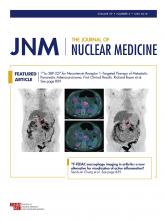Johannes Czernin
More than a year ago, the U.S. Food and Drug Administration (FDA) and the Centers for Medicare and Medicaid services (CMS) approved and reimbursed 68Ga-DOTATATE PET imaging for patients with neuroendocrine tumors (NETs). The biodistribution and dosimetry of 68Ga-DOTATATE, reviewed by Bodei et al. are favorable (2). The interobserver agreement of 68Ga-DOTATATE images is robust (3). The diagnostic accuracy of 68Ga-DOTATATE (and DOTATOC) is high (4) and is without any doubt superior to that of 111In-Octreotide (5). Finally, a significant impact of 68Ga-DOTATATE on managing patients with NETs has been established (6,7), and most intended management changes after 68Ga-DOTATATE PET/CT are in fact implemented (8).
In its last PET coverage review published online on March 30, 2018 (http://www.aetna.com/cpb/medical/data/1_99/0071.html), Aetna elected to ignore this evidence and claimed under section B.39: “Aetna considers Ga 68 Dotatate PET (Netspot) experimental and investigational for neuroendocrine tumors and for all other indications.” Similar opinions have delayed the adoption and acceptance of 18F-FDG PET imaging for many years in the United States and for decades in other countries (1).
What are the thought processes that result in these decisions? Or better, are there any thought processes that inform these decisions? Are these based on expert opinions or, more likely, simple knee-jerk rejections in response to emerging new diagnostic PET assays? Are these supposed to result in cost savings when in fact the costs associated with this imaging test are negligible? (It is noteworthy that Aetna reported a full-year 2017 net income of $1.9 billion.) Do these regulators understand that there is no difference in cost between the superior diagnostic accuracy of 68Ga-DOTATATE and the inferior diagnostic test that is currently in use?
The noncoverage decision is obviously not based on a careful review of the existing data that show low interobserver variability, highly significant impact on management, high diagnostic accuracy, favorable radiation dosimetry, and short outpatient visits of around 2 h for 68Ga-DOTATATE versus days of returns to the clinic for 111In-Octreotide (3–8).
Do the evaluators understand the concept and relevance of assessing target expression as a predictive biomarker for a highly efficient theranostic approach (9)? Do these experts grasp the concept of theranostics? Do they understand why documenting target expression is highly relevant before the target can be exploited therapeutically? Do they understand that anatomic localization (lung vs. gut, etc.) does not affect response as long as the therapeutic target is expressed? Do they understand that if both tests were offered, every imaging expert and every patient would pick 68Ga-DOTATATE PET/CT over 111In-Octreotide SPECT/CT?
Do they understand how disenfranchised informed patients feel when they are denied the best available diagnostic workup simply because health-care “experts” feel that there is insufficient evidence?
Analyzing the entire Aetna PET coverage document is beyond the scope of this editorial (however tempting it may be to look at this much more carefully). The issue here is what we can do to support patients with NETs. Aetna has elected the easy way out by simply denying coverage for a service that is FDA-approved and CMS-reimbursed (10); they ignore the fact that 68Ga-DOTATATE and 68Ga-DOTATATOC are used worldwide for initial and subsequent management decisions and for stratifying NET patients to the most effective treatment (177Lu-DOTATATE) which is also FDA-approved and CMS-reimbursed (9,11). They are oblivious to the entire concept of precision medicine for which the theranostic pair 68Ga/177Lu-DOTATATE is a uniquely successful example.
Aetna is consistent in ignoring FDA and CMS decisions as it also denies coverage for the amino acid transport substrate fluciclovine (axumin), which is also FDA-approved and CMS-reimbursed (10) but not covered by Aetna.
To the community of patients with NETs: it is time to get angry about mindless and restrictive coverage decisions for diagnostic tests that can make a huge difference in your lives.
To referring and treating physicians: support your patients in this fight as strongly and forcefully as possible. We see the benefits of somatostatin receptor–targeted PET diagnostics and theranostics every day in the clinic.
- © 2018 by the Society of Nuclear Medicine and Molecular Imaging.








